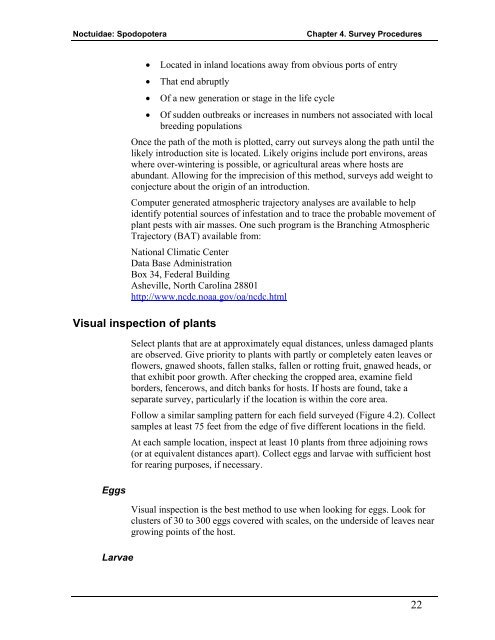New Pest Response Guidelines - Phytosanitary Resources
New Pest Response Guidelines - Phytosanitary Resources
New Pest Response Guidelines - Phytosanitary Resources
You also want an ePaper? Increase the reach of your titles
YUMPU automatically turns print PDFs into web optimized ePapers that Google loves.
Noctuidae: Spodopotera<br />
Chapter 4. Survey Procedures<br />
• Located in inland locations away from obvious ports of entry<br />
• That end abruptly<br />
• Of a new generation or stage in the life cycle<br />
• Of sudden outbreaks or increases in numbers not associated with local<br />
breeding populations<br />
Once the path of the moth is plotted, carry out surveys along the path until the<br />
likely introduction site is located. Likely origins include port environs, areas<br />
where over-wintering is possible, or agricultural areas where hosts are<br />
abundant. Allowing for the imprecision of this method, surveys add weight to<br />
conjecture about the origin of an introduction.<br />
Computer generated atmospheric trajectory analyses are available to help<br />
identify potential sources of infestation and to trace the probable movement of<br />
plant pests with air masses. One such program is the Branching Atmospheric<br />
Trajectory (BAT) available from:<br />
National Climatic Center<br />
Data Base Administration<br />
Box 34, Federal Building<br />
Asheville, North Carolina 28801<br />
http://www.ncdc.noaa.gov/oa/ncdc.html<br />
Visual inspection of plants<br />
Eggs<br />
Larvae<br />
Select plants that are at approximately equal distances, unless damaged plants<br />
are observed. Give priority to plants with partly or completely eaten leaves or<br />
flowers, gnawed shoots, fallen stalks, fallen or rotting fruit, gnawed heads, or<br />
that exhibit poor growth. After checking the cropped area, examine field<br />
borders, fencerows, and ditch banks for hosts. If hosts are found, take a<br />
separate survey, particularly if the location is within the core area.<br />
Follow a similar sampling pattern for each field surveyed (Figure 4.2). Collect<br />
samples at least 75 feet from the edge of five different locations in the field.<br />
At each sample location, inspect at least 10 plants from three adjoining rows<br />
(or at equivalent distances apart). Collect eggs and larvae with sufficient host<br />
for rearing purposes, if necessary.<br />
Visual inspection is the best method to use when looking for eggs. Look for<br />
clusters of 30 to 300 eggs covered with scales, on the underside of leaves near<br />
growing points of the host.<br />
22













